14 Examples of Formative Assessment [+FAQs]

Traditional student assessment typically comes in the form of a test, pop quiz, or more thorough final exam. But as many teachers will tell you, these rarely tell the whole story or accurately determine just how well a student has learned a concept or lesson.
That’s why many teachers are utilizing formative assessments. While formative assessment is not necessarily a new tool, it is becoming increasingly popular amongst K-12 educators across all subject levels.
Curious? Read on to learn more about types of formative assessment and where you can access additional resources to help you incorporate this new evaluation style into your classroom.

What is Formative Assessment?
Online education glossary EdGlossary defines formative assessment as “a wide variety of methods that teachers use to conduct in-process evaluations of student comprehension, learning needs, and academic progress during a lesson, unit, or course.” They continue, “formative assessments help teachers identify concepts that students are struggling to understand, skills they are having difficulty acquiring, or learning standards they have not yet achieved so that adjustments can be made to lessons, instructional techniques, and academic support.”
The primary reason educators utilize formative assessment, and its primary goal, is to measure a student’s understanding while instruction is happening. Formative assessments allow teachers to collect lots of information about a student’s comprehension while they’re learning, which in turn allows them to make adjustments and improvements in the moment. And, the results speak for themselves — formative assessment has been proven to be highly effective in raising the level of student attainment, increasing equity of student outcomes, and improving students’ ability to learn, according to a study from the Organization for Economic Co-operation and Development (OECD).
On the flipside of the assessment coin is summative assessments, which are what we typically use to evaluate student learning. Summative assessments are used after a specific instructional period, such as at the end of a unit, course, semester, or even school year. As learning and formative assessment expert Paul Black puts it, “when the cook tastes the soup, that’s formative assessment. When a customer tastes the soup, that’s summative assessment.”
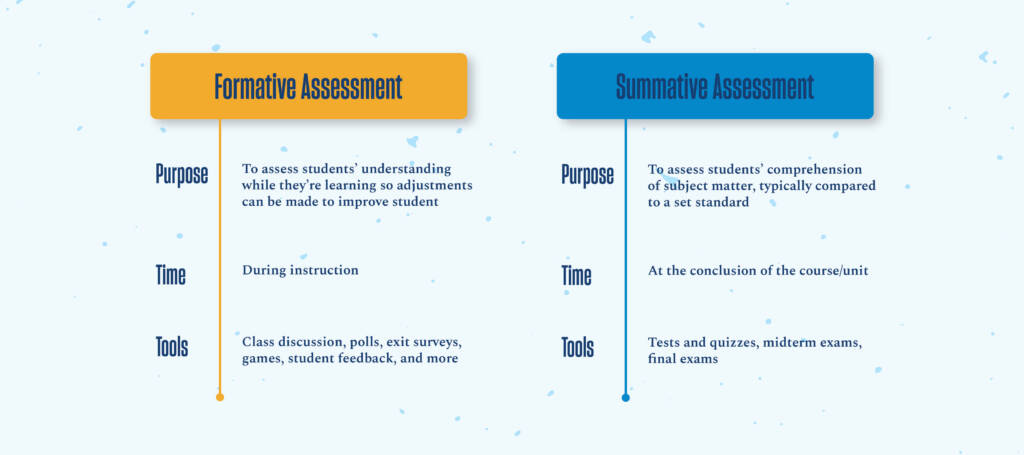
14 Examples of Formative Assessment Tools & Strategies
There are many types of formative assessment tools and strategies available to teachers, and it’s even possible to come up with your own. However, here are some of the most popular and useful formative assessments being used today.
- Round Robin Charts
Students break out into small groups and are given a blank chart and writing utensils. In these groups, everyone answers an open-ended question about the current lesson. Beyond the question, students can also add any relevant knowledge they have about the topic to their chart. These charts then rotate from group to group, with each group adding their input. Once everyone has written on every chart, the class regroups and discusses the responses.
- Strategic Questioning
This formative assessment style is quite flexible and can be used in many different settings. You can ask individuals, groups, or the whole class high-level, open-ended questions that start with “why” or “how.” These questions have a two-fold purpose — to gauge how well students are grasping the lesson at hand and to spark a discussion about the topic.
- Three-Way Summaries
These written summaries of a lesson or subject ask students to complete three separate write-ups of varying lengths: short (10-15 words), medium (30-50 words), and long (75-100). These different lengths test students’ ability to condense everything they’ve learned into a concise statement, or elaborate with more detail. This will demonstrate to you, the teacher, just how much they have learned, and it will also identify any learning gaps.
- Think-Pair-Share
Think-pair-share asks students to write down their answers to a question posed by the teacher. When they’re done, they break off into pairs and share their answers and discuss. You can then move around the room, dropping in on discussions and getting an idea of how well students are understanding.
Looking for a competitive edge? Explore our Education certificate options today! >
- 3-2-1 Countdown
This formative assessment tool can be written or oral and asks students to respond to three very simple prompts: Name three things you didn’t know before, name two things that surprised you about this topic, and name one you want to start doing with what you’ve learned. The exact questions are flexible and can be tailored to whatever unit or lesson you are teaching.
- Classroom Polls
This is a great participation tool to use mid-lesson. At any point, pose a poll question to students and ask them to respond by raising their hand. If you have the capability, you can also use online polling platforms and let students submit their answers on their Chromebooks, tablets, or other devices.
- Exit/Admission Tickets
Exit and admission tickets are quick written exercises that assess a student’s comprehension of a single day’s lesson. As the name suggests, exit tickets are short written summaries of what students learned in class that day, while admission tickets can be performed as short homework assignments that are handed in as students arrive to class.
- One-Minute Papers
This quick, formative assessment tool is most useful at the end of the day to get a complete picture of the classes’ learning that day. Put one minute on the clock and pose a question to students about the primary subject for the day. Typical questions might be:
- What was the main point?
- What questions do you still have?
- What was the most surprising thing you learned?
- What was the most confusing aspect and why?
- Creative Extension Projects
These types of assessments are likely already part of your evaluation strategy and include projects like posters and collage, skit performances, dioramas, keynote presentations, and more. Formative assessments like these allow students to use more creative parts of their skillset to demonstrate their understanding and comprehension and can be an opportunity for individual or group work.
Dipsticks — named after the quick and easy tool we use to check our car’s oil levels — refer to a number of fast, formative assessment tools. These are most effective immediately after giving students feedback and allowing them to practice said skills. Many of the assessments on this list fall into the dipstick categories, but additional options include writing a letter explaining the concepts covered or drawing a sketch to visually represent the topic.
- Quiz-Like Games and Polls
A majority of students enjoy games of some kind, and incorporating games that test a student’s recall and subject aptitude are a great way to make formative assessment more fun. These could be Jeopardy-like games that you can tailor around a specific topic, or even an online platform that leverages your own lessons. But no matter what game you choose, these are often a big hit with students.
- Interview-Based Assessments
Interview-based assessments are a great way to get first-hand insight into student comprehension of a subject. You can break out into one-on-one sessions with students, or allow them to conduct interviews in small groups. These should be quick, casual conversations that go over the biggest takeaways from your lesson. If you want to provide structure to student conversations, let them try the TAG feedback method — tell your peer something they did well, ask a thoughtful question, and give a positive suggestion.
- Self Assessment
Allow students to take the rubric you use to perform a self assessment of their knowledge or understanding of a topic. Not only will it allow them to reflect on their own work, but it will also very clearly demonstrate the gaps they need filled in. Self assessments should also allow students to highlight where they feel their strengths are so the feedback isn’t entirely negative.
- Participation Cards
Participation cards are a great tool you can use on-the-fly in the middle of a lesson to get a quick read on the entire classes’ level of understanding. Give each student three participation cards — “I agree,” “I disagree,” and “I don’t know how to respond” — and pose questions that they can then respond to with those cards. This will give you a quick gauge of what concepts need more coverage.
5 REASONS WHY CONTINUING EDUCATION MATTERS FOR EDUCATORS
The education industry is always changing and evolving, perhaps now more than ever. Learn how you can be prepared by downloading our eBook.
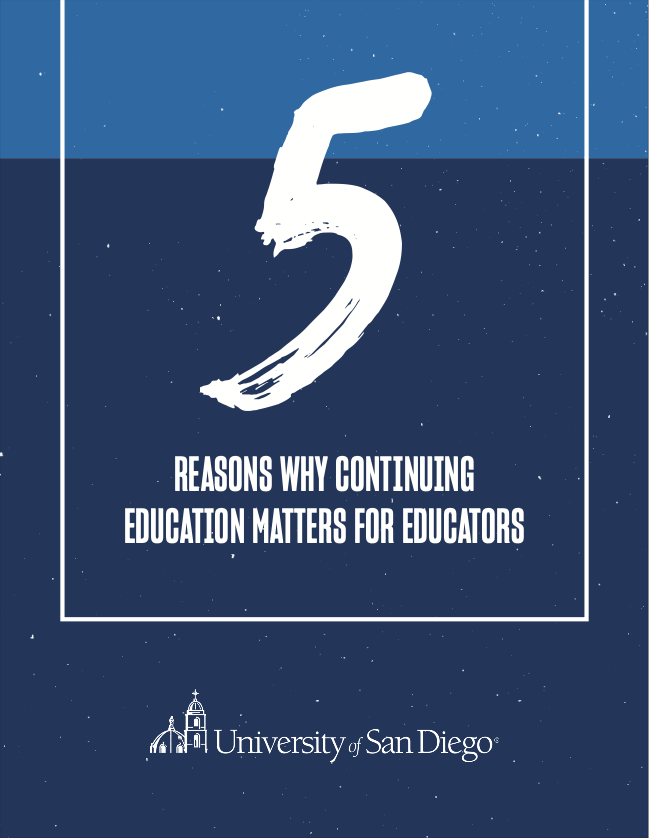
List of Formative Assessment Resources
There are many, many online formative assessment resources available to teachers. Here are just a few of the most widely-used and highly recommended formative assessment sites available.
- Arizona State Dept of Education
FAQs About Formative Assessment
The following frequently asked questions were sourced from the Association for Supervision and Curriculum Development (ASCD), a leading education professional organization of more than 100,000 superintendents, principals, teachers, and advocates.
Is formative assessment something new?
No and yes. The concept of measuring a student’s comprehension during lessons has existed for centuries. However, the concept of formative assessment as we understand it didn’t appear until approximately 40 years ago, and has progressively expanded into what it is today.
What makes something a formative assessment?
ASCD characterized formative assessment as “a way for teachers and students to gather evidence of learning, engage students in assessment, and use data to improve teaching and learning.” Their definition continues, “when you use an assessment instrument— a test, a quiz, an essay, or any other kind of classroom activity—analytically and diagnostically to measure the process of learning and then, in turn, to inform yourself or your students of progress and guide further learning, you are engaging in formative assessment. If you were to use the same instrument for the sole purpose of gathering data to report to a district or state or to determine a final grade, you would be engaging in summative assessment.”
Does formative assessment work in all content areas?
Absolutely, and it works across all grade levels. Nearly any content area — language arts, math, science, humanities, and even the arts or physical education — can utilize formative assessment in a positive way.
How can formative assessment support the curriculum?
Formative assessment supports curricula by providing real-time feedback on students’ knowledge levels and comprehension of the subject at hand. When teachers regularly utilize formative assessment tools, they can find gaps in student learning and customize lessons to fill those gaps. After term is over, teachers can use this feedback to reshape their curricula.
How can formative assessment be used to establish instructional priorities?
Because formative assessment supports curriculum development and updates, it thereby influences instructional priorities. Through student feedback and formative assessment, teachers are able to gather data about which instructional methods are most (and least) successful. This “data-driven” instruction should yield more positive learning outcomes for students.
Can formative assessment close achievement gaps?
Formative assessment is ideal because it identifies gaps in student knowledge while they’re learning. This allows teachers to make adjustments to close these gaps and help students more successfully master a new skill or topic.
How can I help my students understand formative assessment?
Formative assessment should be framed as a supportive learning tool; it’s a very different tactic than summative assessment strategies. To help students understand this new evaluation style, make sure you utilize it from the first day in the classroom. Introduce a small number of strategies and use them repeatedly so students become familiar with them. Eventually, these formative assessments will become second nature to teachers and students.
Before you tackle formative assessment, or any new teaching strategy for that matter, consider taking a continuing education course. At the University of San Diego School of Professional and Continuing Education, we offer over 500 courses for educators that can be completed entirely online, and many at your own pace. So no matter what your interests are, you can surely find a course — or even a certificate — that suits your needs.
Be Sure To Share This Article
- Share on Twitter
- Share on Facebook
- Share on LinkedIn
Related Posts

Your Salary
Browse over 500+ educator courses and numerous certificates to enhance your curriculum and earn credit toward salary advancement.
Formative Assessment of Teaching
What is formative assessment of teaching.
How do you know if your teaching is effective? How can you identify areas where your teaching can improve? What does it look like to assess teaching?
Formative Assessment
Formative assessment of teaching consists of different approaches to continuously evaluate your teaching. The insight gained from this assessment can support revising your teaching strategies, leading to better outcomes in student learning and experiences. Formative assessment can be contrasted with summative assessment, which is usually part of an evaluative decision-making process. The table below outlines some of the key differences between formative and summative assessment:
By participating in formative assessment, instructors connect with recent developments in the space of teaching and learning, as well as incorporate new ideas into their practice. Developments may include changes in the students we serve, changes in our understanding of effective teaching, and changes in expectations of the discipline and of higher education as a whole.
Formative assessment of teaching ultimately should guide instructors towards using more effective teaching practices. What does effectiveness mean in terms of teaching?
Effectiveness in Teaching
Effective teaching can be defined as teaching that leads to the intended outcomes in student learning and experiences. In this sense, there is no single perfect teaching approach. Effective teaching looks will depend on the stated goals for student learning and experiences. A course that aims to build student confidence in statistical analysis and a course that aims to develop student writing could use very different teaching strategies, and still both be effective at accomplishing their respective goals.
Assessing student learning and experiences is critical to determining if teaching is truly effective in its context. This assessment can be quite complex, but it is doable. In addition to measuring the impacts of your teaching, you may also consider evaluating your teaching as it aligns with best practices for evidence-based teaching especially in the disciplinary and course context or aligns with your intended teaching approach. The table below outlines these three approaches to assessing the effectiveness of your teaching:
What are some strategies that I might try?
There are multiple ways that instructors might begin to assess their teaching. The list below includes approaches that may be done solo, with colleagues, or with the input of students. Instructors may pursue one or more of these strategies at different points in time. With each possible strategy, we have included several examples of the strategy in practice from a variety of institutions and contexts.
Teaching Portfolios
Teaching portfolios are well-suited for formative assessment of teaching, as the portfolio format lends itself to documenting how your teaching has evolved over time. Instructors can use their teaching portfolios as a reflective practice to review past teaching experiences, what worked and what did not.
Teaching portfolios consist of various pieces of evidence about your teaching such as course syllabi, outlines, lesson plans, course evaluations, and more. Instructors curate these pieces of evidence into a collection, giving them the chance to highlight their own growth and focus as educators. While student input may be incorporated as part of the portfolio, instructors can contextualize and respond to student feedback, giving them the chance to tell their own teaching story from a more holistic perspective.
Teaching portfolios encourage self-reflection, especially with guided questions or rubrics to review your work. In addition, an instructor might consider sharing their entire teaching portfolio or selected materials for a single course with colleagues and engaging in a peer review discussion.
Examples and Resources:
Teaching Portfolio - Career Center
Developing a Statement of Teaching Philosophy and Teaching Portfolio - GSI Teaching & Resource Center
Self Assessment - UCLA Center for Education, Innovation, and Learning in the Sciences
Advancing Inclusion and Anti-Racism in the College Classroom Rubric and Guide
Course Design Equity and Inclusion Rubric
Teaching Demos or Peer Observation
Teaching demonstrations or peer classroom observation provide opportunities to get feedback on your teaching practice, including communication skills or classroom management.
Teaching demonstrations may be arranged as a simulated classroom environment in front of a live audience who take notes and then deliver summarized feedback. Alternatively, demonstrations may involve recording an instructor teaching to an empty room, and this recording can be subjected to later self-review or peer review. Evaluation of teaching demos will often focus on the mechanics of teaching especially for a lecture-based class, e.g. pacing of speech, organization of topics, clarity of explanations.
In contrast, instructors may invite a colleague to observe an actual class session to evaluate teaching in an authentic situation. This arrangement gives the observer a better sense of how the instructor interacts with students both individually or in groups, including their approach to answering questions or facilitating participation. The colleague may take general notes on what they observe or evaluate the instructor using a teaching rubric or other structured tool.
Peer Review of Course Instruction
Preparing for a Teaching Demonstration - UC Irvine Center for Educational Effectiveness
Based on Peer Feedback - UCLA Center for Education, Innovation, and Learning in the Sciences
Teaching Practices Equity and Inclusion Rubric
Classroom Observation Protocol for Undergraduate STEM (COPUS)
Student Learning Assessments
Student learning can vary widely across courses or even between academic terms. However, having a clear benchmark for the intended learning objectives and determining whether an instructor’s course as implemented helps students to reach that benchmark can be an invaluable piece of information to guide your teaching. The method for measuring student learning will depend on the stated learning objective, but a well-vetted instrument can provide the most reliable data.
Recommended steps and considerations for using student learning assessments to evaluate your teaching efficacy include:
Identify a small subset of course learning objectives to focus on, as it is more useful to accurately evaluate one objective vs. evaluating many objectives inaccurately.
Find a well-aligned and well-developed measure for each selected course learning objective, such as vetted exam questions, rubrics, or concept inventories.
If relevant, develop a prompt or assignment that will allow students to demonstrate the learning objective to then be evaluated against the measure.
Plan the timing of data collection to enable useful comparison and interpretation.
Do you want to compare how students perform at the start of your course compared to the same students at the end of your course?
Do you want to compare how the same students perform before and after a specific teaching activity?
Do you want to compare how students in one term perform compared to students in the next term, after changing your teaching approach?
Implement the assignment/prompt and evaluate a subset or all of the student work according to the measure.
Reflect on the results and compare student performance measures.
Are students learning as a result of your teaching activity and course design?
Are students learning to the degree that you intended?
Are students learning more when you change how you teach?
This process can be repeated as many times as needed or the process can be restarted to instead focus on a different course learning objective.
List of Concept Inventories (STEM)
Best Practices for Administering Concept Inventories (Physics)
AAC&U VALUE Rubrics
Rubric Bank | Assessment and Curriculum Support Center - University of Hawaiʻi at Mānoa
Rubrics - World Languages Resource Collection - Kennesaw State University
Student Surveys or Focus Groups
Surveys or focus groups are effective tools to better understand the student experience in your courses, as well as to solicit feedback on how courses can be improved. Hearing student voices is critical as students themselves can attest to how course activities made them feel, e.g. whether they perceive the learning environment to be inclusive, or what topics they find interesting.
Some considerations for using student surveys in your teaching include:
Surveys collect individual and anonymous input from as many students as possible.
Surveys can gather both quantitative and qualitative data.
Surveys that are anonymous avoid privileging certain voices over others.
Surveys can enable students to share about sensitive experiences that they may be reluctant to discuss publicly.
Surveys that are anonymous may lend to negative response bias.
Survey options at UC Berkeley include customized course evaluation questions or anonymous surveys on bCourses, Google Forms, or Qualtrics.
Some considerations for using student focus groups in your teaching include:
Focus groups leverage the power of group brainstorming to identify problems and imagine possible solutions.
Focus groups can gather both rich and nuanced qualitative data.
Focus groups with a skilled facilitator tend to have more moderated responses given the visibility of the discussion.
Focus groups take planning, preparation, and dedicated class time.
Focus group options at UC Berkeley include scheduling a Mid-semester Inquiry (MSI) to be facilitated by a CTL staff member.
Instructions for completing question customization for your evaluations as an instructor
Course Evaluations Question Bank
Student-Centered Evaluation Questions for Remote Learning
Based on Student Feedback - UCLA Center for Education, Innovation, and Learning in the Sciences
How Can Instructors Encourage Students to Complete Course Evaluations and Provide Informative Responses?
Student Views/Attitudes/Affective Instruments - ASBMB
Student Skills Inventories - ASBMB
How might I get started?
Self-assess your own course materials using one of the available rubrics listed above.
Schedule a teaching observation with CTL to get a colleague’s feedback on your teaching practices and notes on student engagement.
Schedule an MSI with CTL to gather directed student feedback with the support of a colleague.
Have more questions? Schedule a general consultation with CTL or send us your questions by email ( [email protected] )!
References:
Evaluating Teaching - UCSB Instructional Development
Documenting Teaching - UCSC Center for Innovations in Teaching and Learning
Other Forms of Evaluation - UCLA Center for Education, Innovation, and Learning in the Sciences
Evaluation Of Teaching Committee on Teaching, Academic Senate
Report of the Academic Council Teaching Evaluation Task Force
Teaching Quality Framework Initiative Resources - University of Colorado Boulder
Benchmarks for Teaching Effectiveness - University of Kansas Center for Teaching Excellence
Teaching Practices Instruments - ASBMB
Personalised Maths Tutoring
A personalised one to one learning journey for every pupil who needs it, guided by teacher insights and intelligent assessments
Hundreds of FREE online maths resources
Daily activities, ready-to-go lesson slides, SATs revision packs, video CPD and more!

What Is Formative Assessment: A Practical Guide To When And How To Use It
Zoe Benjamin
Read this guide to formative assessment to find out what it means, how to use it most effectively and what challenges and pitfalls to look out for.
Dylan Wiliam has described formative assessment as a cornerstone of outstanding lessons and an essential area for ongoing professional development. So, if you are keen to unlock the full potential of your teaching and help your students excel, it’s time to embrace the power of formative assessment!
What is formative assessment?
Formative assessment is the process of monitoring and assessing students’ learning and understanding in order to adapt your teaching methods to better address students’ learning needs. The result of this continual formative feedback is that both teacher and student know the areas of greatest strength and the areas for improvement. Formative assessment is by its nature a low stakes form of assessment.
One way to view formative assessment is that it is a way for pupils to provide feedback to their teacher about whether they are on track to achieve the learning outcomes for the lesson.
Although the feedback is provided by pupils, it is the responsibility of the teacher to ensure that pupils are given access to formative assessment opportunities that provide the teacher with accurate and ongoing feedback. The feedback must then also be used carefully to inform the teacher’s next steps.
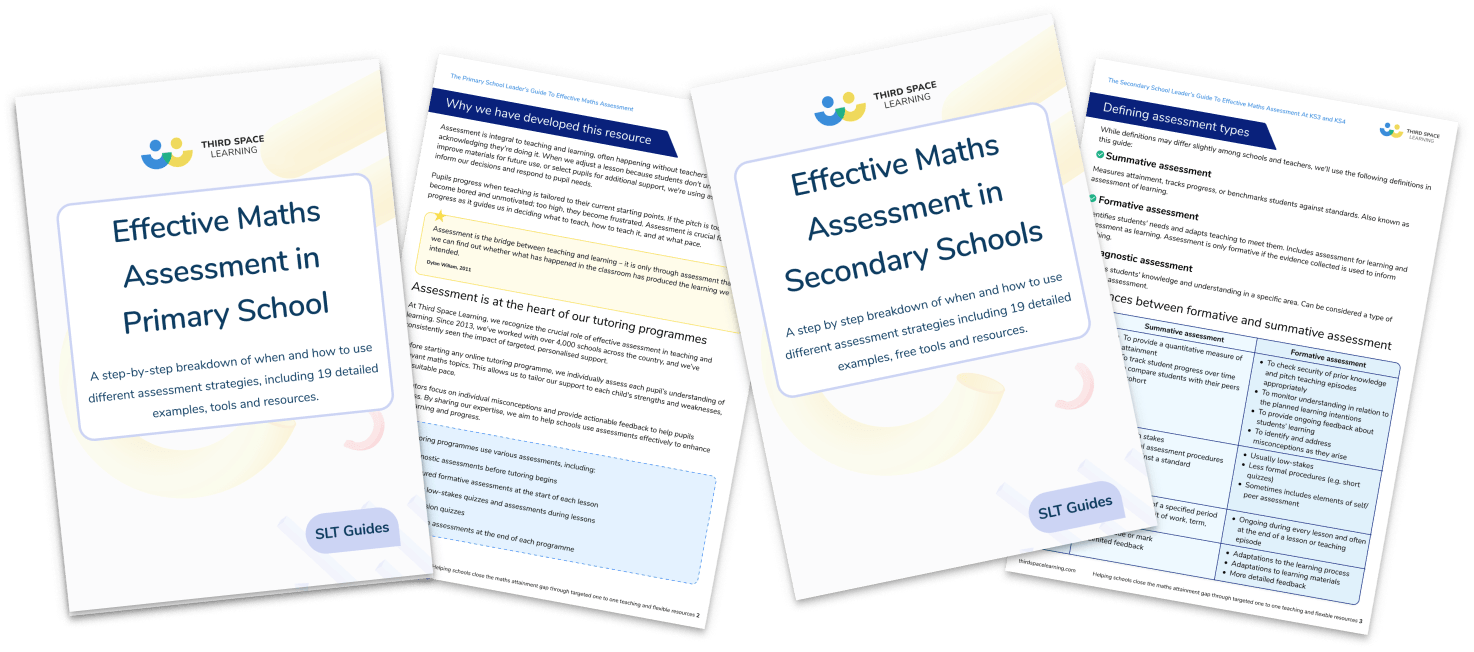
The Ultimate Guide to Maths Assessments
This guide offers a breakdown of primary and secondary math assessments, with proven strategies and free resources to use in the classroom.
Formative assessment is often, but not always relatively quick and in the moment eg asking children to hold up mini whiteboards to assess their understanding of a concept; it can also be much more extensive such as a diagnostic maths test .
Some people will use the term formative assessment as synonymous with assessment for learning or assessment as learning because it utilises assessment to ultimately help the learning process.
Formative assessment vs summative assessment
The difference between formative assessment and summative assessment is best seen in terms of their goals.
The goal of formative assessment is to guide the next stage of teaching and learning and inform the teacher and student on their gaps in skills knowledge.
In contrast, the goal of summative assessment is a snapshot or record of what a pupil has learnt by a particular point in time, often benchmarked against school, trust or national standards.
FREE SUMMATIVE MATHS TESTS
- Year 6 maths test
- Year 7 maths test
- Year 8 maths test
- Year 9 maths test
Formative assessment strategies offer assessment for learning; they provide teachers with the information they need to enhance and track student progress . It is a great starting point to implement differentiation in teaching accurately.
Summative assessment provides an assessment of learning and a measure of student performance.
Summative assessments are more likely to take the form of high stakes classroom assessments like SATs, GCSEs or even end of year tests in a school. Examples of formative assessments will include low stakes quizzes or exit tickets. However, you cannot rely on the format of the assessment alone – it’s all about how it’s used.
Read more: Formative and Summative Assessment: The Differences Explained
What are the benefits of formative assessment?
Wiliam and Leahy (2016) conducted a two-year study in 57 schools to measure the impact that formative assessment has on students’ learning experience. At the end of the study, students in 85% of the schools were responding significantly more to their teachers’ feedback than before the study started.
The five strategies promoted by Wiliam and Leahy were:
- Clarifying, sharing and understanding learning intentions and success criteria
- Engineering effective discussions, tasks, and activities that elicit evidence of learning
- Providing feedback that moves learners forward
- Activating students as learning resources for one another
- Activating students as owners of their own learning.
The benefits of formative assessment include:
- Encourages a culture of reflection and adaptation in students, empowering them to reflect on and adapt their own learning.
- Facilitates teachers in evaluating and refining their teaching strategies based on formative assessment insights.
- Promotes self-evaluation, self-assessment, and metacognition, enabling students to effectively plan, monitor, and evaluate their learning progress.
- Improves students’ academic performance by providing teachers with valuable feedback on student understanding.
- Enables teachers to implement whole class or small group interventions as necessary, ensuring personalised instruction and enhanced learning outcomes .
How formative assessment raises student achievement
1. formative assessment raises student achievement by allowing more targeted teaching.
By analysing the results of carefully planned formative assessment, teachers can develop an accurate picture of their pupil’s current understanding of a given topic. Using this information to inform the next steps in the lesson and future lesson planning can allow gaps in understanding to be closed and improve pupil outcomes.

2. Formative assessment can raise pupil achievement by improving their self-evaluation
If the results of formative assessment are shared with pupils and appropriate targeted teaching strategies are implemented, they can begin to identify whether a solution is accurate, which methods are most effective and when it is appropriate to use them. However due to the Dunning-Kruger effect – a cognitive bias causing students to overestimate their own achievement – it is vital that the ability of a student to accurately self-evaluate their understanding is itself continually assessed and monitored.
3. Formative assessment encourages students metacognitive skills
As they receive ongoing feedback they are exposed to a range of formative assessment methods and become more involved in their learning; metacognition is a proven technique to raise academic achievement.
READ MORE : How to teach metacognitive skills
Examples of formative assessment
The formative assessment technique you choose will depend on the situation, your current knowledge of the student, and what outcome you require from your assessment. The most reliable information about pupil knowledge comes from formative assessment activities consciously designed to uncover what students do and don’t know and and expose misconceptions.
Some of these formative assessment examples by their nature will be diagnostic i.e. with the primary goal of identifying and evaluating students’ current knowledge and understanding in a specific content domain.
The most effective examples of formative assessment are:
- Diagnostic questions
- Low stakes quizzes
- Mini whiteboards
- Problem pairs
- Examples and non-examples
- Exit tickets or exit slips
- Shadow tests
- Comment-only marking
- Metacognitive prompts
- One-minute papers
- Always, sometimes, never
- Directed questioning
- Open-ended questions
- Identifying misconceptions
- Concept map
- Mark scheme or rubric
- Homework tasks
Read more: The best formative assessment examples .
How to use formative assessment as part of your intervention
We recommend every intervention should have some level of formative assessment at the end or beginning to inform the next lesson. This is because the best interventions by their nature are targeted and focused on an individual student’s needs as is the case for our one to one online maths tuition .
At Third Space Learning, pupils complete post session questions after their online one to one maths tutoring sessions. Pupils will be asked questions related to the Learning Objective(s) they’ve covered with their tutor in that session, as well as Learning Objectives they’ve not yet covered. This helps us understand both how well they’ve understood the content of the lesson, and which Learning Objectives they still need to cover in future tutoring sessions. Teachers can access the results of pupils’ post session questions anytime on our online platform.
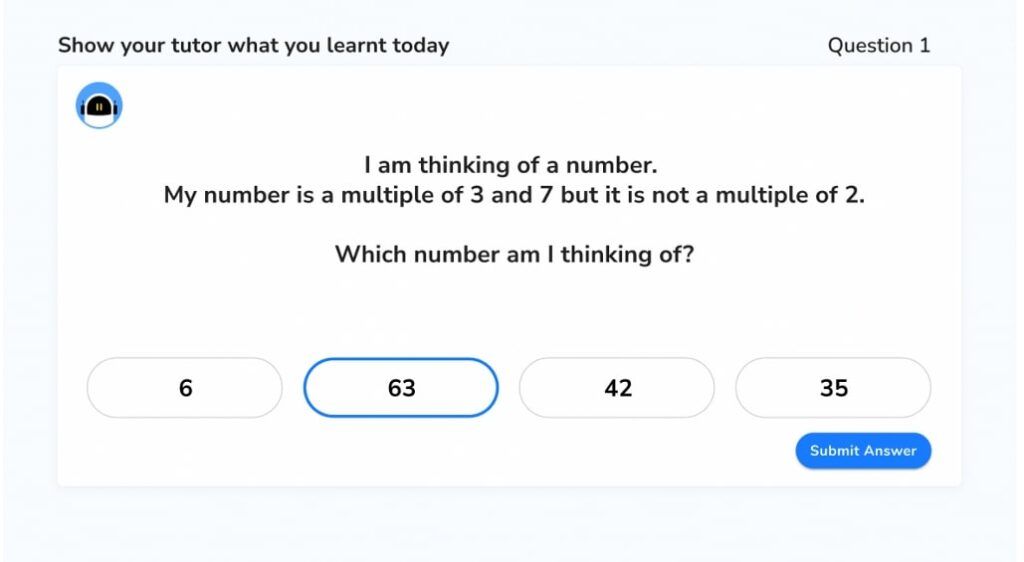
The importance of formative feedback
The success of formative assessment relies on teachers being able to give clear and concise feedback that helps students move from their current level of understanding to the next level.
When feedback gives pupils explicit instructions that move their learning forward, it is called formative feedback. Formative assessments that are not followed by effective formative feedback will not improve student attainment.
Examples of formative feedback
Formative feedback is crucial for students to improve their academic performance by gaining insights into their strengths and weaknesses.
This can be given on an individual basis, either verbal or written, or it may be given to a whole class following a low-stakes quiz or at the start of a lesson in response to the information gained from the previous lesson’s exit ticket.
The following examples illustrate the types of formative feedback seen in maths lessons:
1. Verbal formative feedback
A teacher explains to a student that they have mixed up the definitions of factors and multiples.
They might remind the pupil that the word multiple means ‘lots of’ something to help them remember that they can use their times tables to identify the multiples of a number.
2. Written formative feedback
In response to the work shown below in a student’s exercise book, a teacher writes: ‘Remember that the denominators do not need to be the same when multiplying fractions. Try this question again by multiplying the numerators and denominators together for the original question’.
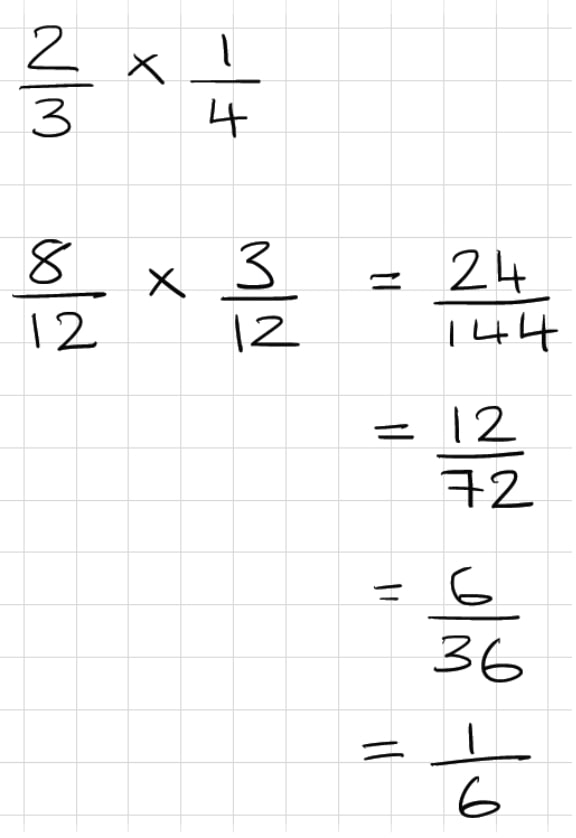
3. Whole class formative feedback
Following the completion of the nth term exit ticket shown in the examples above, the teacher begins the next lesson with a recap for finding the nth term of a quadratic sequence emphasising the need to divide the common difference by two.
Challenges associated with formative assessment processes
Formative assessment is a crucial aspect of evaluating student work and adjusting instruction to meet their needs. Nevertheless, teachers encounter challenges in implementing effective practices:
1. Ensuring accurate reflection of student learning
David Didau has argued that there must be a period of time between the new knowledge acquired and the formative assessment. Otherwise the assessment becomes a measure of student performance rather than student learning.
He argues that when students are shown a new method during a lesson, say expanding double brackets, any assessment of their ability to do that during the same lesson is a measure of memory and performance rather than learning and understanding.
If we consider learning to be a permanent change in students’ long-term memories, then it is difficult to argue that any assessment completed soon after a new method has been taught can accurately predict whether it has been successfully learnt.
As Wiliam and others have pointed out, the point of eliciting evidence of learning via formative techniques is to incrementally increase the probability that the learning that has taken place matches the initial learning intentions – the more you check and correct, the more likely this becomes. No formative assessment technique can definitively confirm that learning has occurred.
Despite this criticism, it is still important to know whether pupils can independently reproduce a new method during the lesson in which it has first been taught.
Even if we are only measuring performance at this stage in the learning process, being able to successfully perform a new skill is still a prerequisite to being able to do it at a future date.
If a student is not able to demonstrate understanding of a new topic during the lesson it is important that the teacher has that information and adjusts their teaching strategy accordingly.
Testing previously learnt material through a low stakes quiz at the start of a lesson is likely to be an accurate assessment of learning rather than performance, particularly if the material being tested was taught in the previous month or term.
Providing students with retrieval practice in this way will strengthen the connections in their long-term memory, activate prior knowledge, and allow teachers to know whether previously learnt material needs to be retaught.
2. Selecting effective questions to identify specific learning gaps
Another challenge associated with formative assessment is selecting the right questions to include in the assessment materials.
Poorly chosen questions can identify that a student has not fully understood a topic but will not be able to identify which specific part has been misunderstood.
It is much more effective to include diagnostic questions when creating formative assessments. Diagnostic questions are specifically designed to give a greater insight into students’ cognitive processes and produce answers that allow the teacher to know which specific part of the topic has not been understood.
In the example below, each incorrect answer will reveal the nature of students’ misunderstanding.
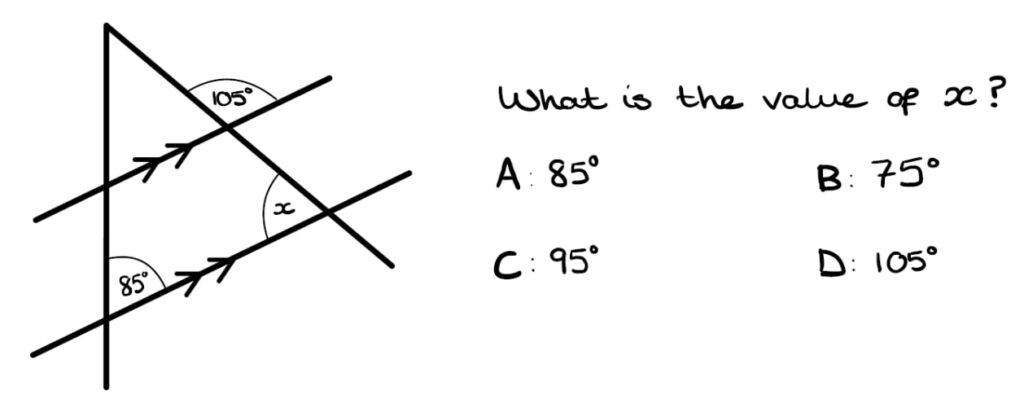
B is the correct answer. Each incorrect answer reveals the learner’s misconception :
- Answer A: triangle is isosceles.
- Answer C: 85° and x add to 180.°
- Answer D: 105° and x are corresponding angles.
You may also be interested in:
- What NEW KS1 Assessment Frameworks Mean For KS2 [Maths]
- Pupil Progress: Measuring The Impact Of The Affective Domain Across 1,750 Schools
- Primary School Grades Explained: Levels, Attainment, Achievement & Progress
- The Myth of Expected Progress in Primary Schools
- Embedding Formal Assessment by Dylan Wiliam and Siobhan Leahy
- Applying An I do, We Do, You Do Pedagogy To Every Lesson
- Benefits Of On-to-one Tutoring
Formative assessment FAQs
The difference between these two types of assessment is that summative assessments produce a measure of student attainment; they are usually presented in the form of a high-stakes assessment. The results have little or no impact on subsequent teaching. On the other hand, formative assessments produce a measure of attainment and are designed to identify students’ misconceptions. Teachers use the results of formative assessments to adapt their teaching and improve pupil progress.
Formative assessment allows teachers to quickly check their pupils’ understanding and identify how they should adapt their teaching to improve student attainment. Ongoing formative feedback also helps pupils to develop metacognitive skills which supports them to become self-regulated learners.
Use formative assessment to test prior knowledge to ensure you are testing learning rather than performance. Design your formative assessment questions so that each incorrect answer reveals students’ specific misunderstanding.
DO YOU HAVE STUDENTS WHO NEED MORE SUPPORT IN MATHS?
Every week Third Space Learning’s maths specialist tutors support thousands of students across hundreds of schools with weekly maths intervention programmes designed to plug gaps and boost progress.
Since 2013 these personalised one to one lessons have helped over 169,000 primary and secondary students become more confident, able mathematicians.
Learn about the diagnostic assessment or request a personalised quote for your school to speak to us about your school’s needs and how we can help.
Related articles

I Do We Do You Do: How To Introduce New Learning Effectively
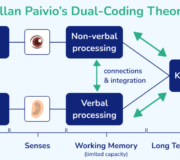
How Dual Coding Can Increase Student Learning: A Guide For Teachers

A Teacher’s Guide To Using Effective Differentiation In Teaching
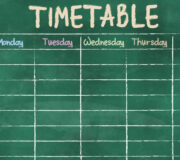
A Teacher’s Guide To Spaced Repetition And Creating An Effective Spaced Repetition Schedule
FREE Guide to Hands on Manipulatives
Download our free guide to manipulatives that you can use in the maths classroom.
Includes 15 of the best concrete resources every KS1 and KS2 classroom should have.
Privacy Overview
- Grades 6-12
- School Leaders
Don’t Miss Your Chance. This Competition Teaches Video + Digital Storytelling Skills!
What Is Formative Assessment and How Should Teachers Use It?
Check student progress as they learn, and adapt to their needs.
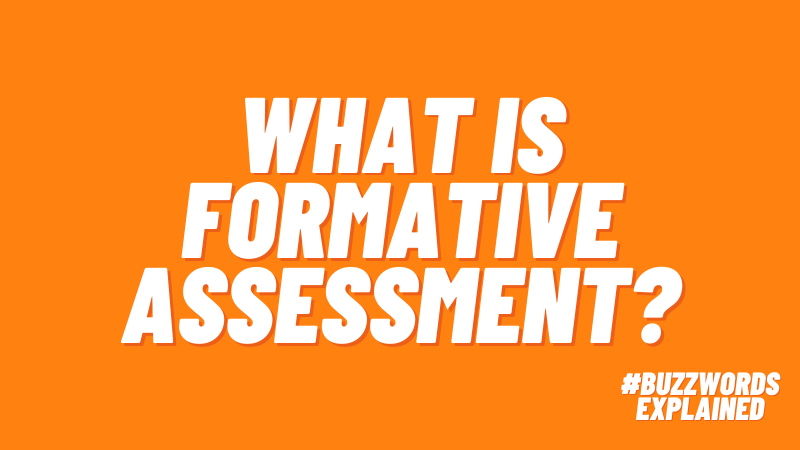
Assessments are a regular part of the learning process, giving both teachers and students a chance to measure their progress. There are several common types of assessments, including pre-assessment (diagnostic) and post-assessment (summative). Some educators, though, argue that the most important of all are formative assessments. So, what is formative assessment, and how can you use it effectively with your students? Read on to find out.
What is formative assessment?
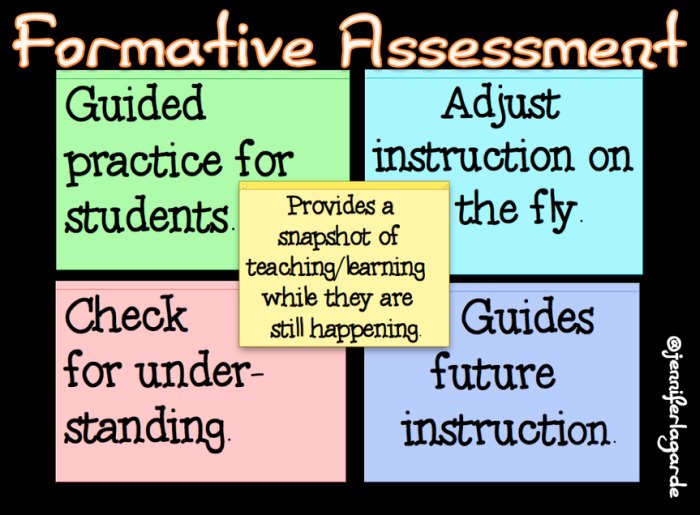
Source: KNILT
Formative assessment takes place while learning is still happening. In other words, teachers use formative assessment to gauge student progress throughout a lesson or activity. This can take many forms (see below), depending on the teacher, subject, and learning environment. Here are some key characteristics of this type of assessment:
Low-Stakes (or No-Stakes)
Most formative assessments aren’t graded, or at least aren’t used in calculating student grades at the end of the grading period. Instead, they’re part of the daily give-and-take between teachers and students. They’re often quick and used immediately after teaching a specific objective.
Planned and Part of the Lesson
Rather than just being quick check-for-understanding questions many teachers ask on the fly, formative assessments are built into a lesson or activity. Teachers consider the skills or knowledge they want to check on, and use one of many methods to gather information on student progress. Students can also use formative assessments among themselves for self-assessment and peer feedback.
Used to Make Adjustments to Teaching Plans
After gathering student feedback, teachers use that feedback to make adjustments to their lessons or activities as needed. Students who self-assess then know what areas they still need help with and can ask for assistance.
How is formative assessment different from other assessments?
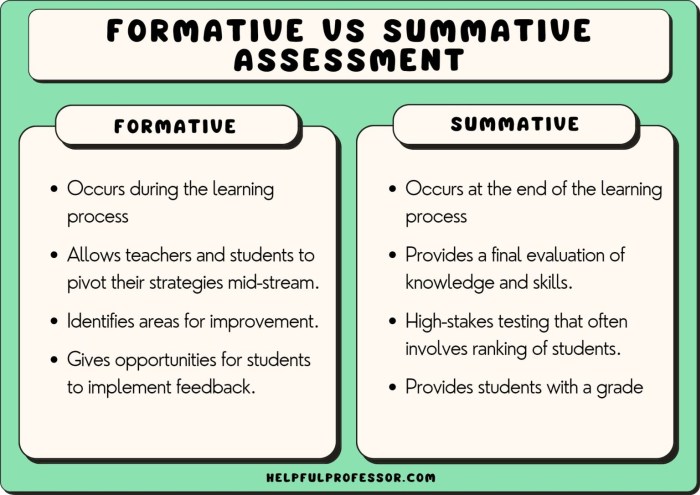
Source: Helpful Professor
There are three general types of assessment: diagnostic, formative, and summative. Diagnostic assessments are used before learning to determine what students already do and do not know. Think pre-tests and other activities students attempt at the beginning of a unit. Teachers may use these to make some adjustments to their planned lessons, skipping or just recapping what students already know.
Diagnostic assessments are the opposite of summative assessments, which are used at the end of a unit or lesson to determine what students have learned. By comparing diagnostic and summative assessments, teachers and learners can get a clearer picture of how much progress they’ve made.
Formative assessments take place during instruction. They’re used throughout the learning process and help teachers make on-the-go adjustments to instruction and activities as needed.
Why is formative assessment important in the classroom?
These assessments give teachers and students a chance to be sure that meaningful learning is really happening. Teachers can try new methods and gauge their effectiveness. Students can experiment with different learning activities, without fear that they’ll be punished for failure. As Chase Nordengren of the NWEA puts it :
“Formative assessment is a critical tool for educators looking to unlock in-depth information on student learning in a world of change. Rather than focusing on a specific test, formative assessment focuses on practices teachers undertake during learning that provide information on student progress toward learning outcomes.”
It’s all about increasing your ability to connect with students and make their learning more effective and meaningful.
What are some examples of formative assessment?
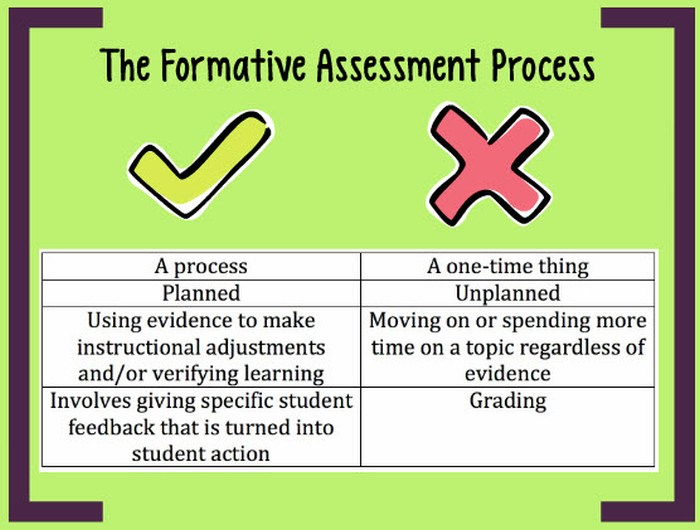
Source: Writing City
There are so many ways teachers can use formative assessments in the classroom! We’ve highlighted a few perennial favorites, but you can find a big list of 25 creative and effective formative assessments options here .
Exit Tickets
At the end of a lesson or class, pose a question for students to answer before they leave. They can answer using a sticky note, online form, or digital tool.
Kahoot Quizzes
Kids and teachers adore Kahoot! Kids enjoy the gamified fun, while teachers appreciate the ability to analyze the data later to see which topics students understand well and which need more time.
We love Flip (formerly Flipgrid) for helping teachers connect with students who hate speaking up in class. This innovative (and free!) tech tool lets students post selfie videos in response to teacher prompts. Kids can view each other’s videos, commenting and continuing the conversation in a low-key way.
What is your favorite way to use formative assessments in the classroom? Come exchange ideas in the WeAreTeachers HELPLINE group on Facebook .
Plus, check out the best tech tools for student assessment ..
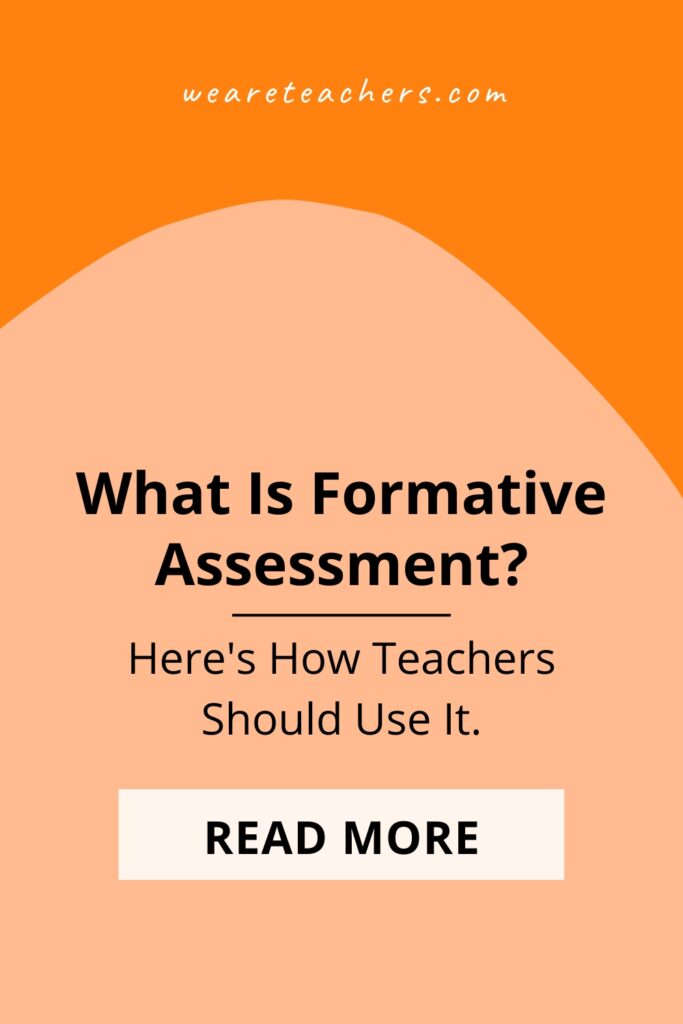
You Might Also Like
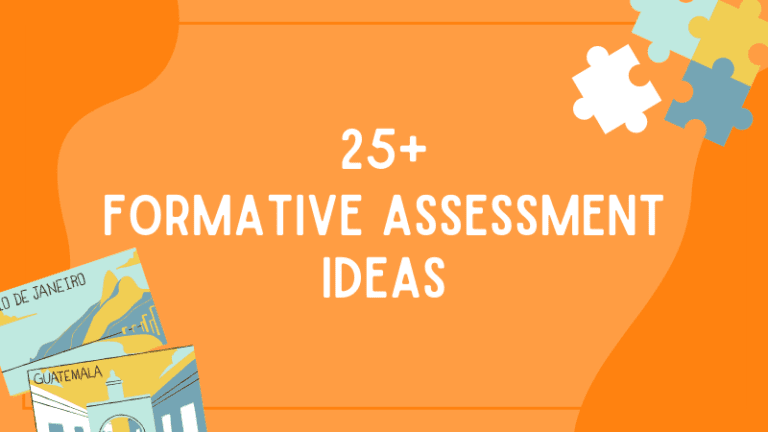
25 Formative Assessment Options Your Students Will Actually Enjoy
Get them excited to show you what they know! Continue Reading
Copyright © 2024. All rights reserved. 5335 Gate Parkway, Jacksonville, FL 32256

COMMENTS
There are many types of formative assessment tools and strategies available to teachers, and it’s even possible to come up with your own. However, here are some of the most popular and useful formative assessments being used today.
There are three broad types of assessments: diagnostic, formative, and summative. These take place throughout the learning process, helping students and teachers gauge learning. Within those three broad categories, you’ll find other types of assessment, such as ipsative, norm-referenced, and criterion-referenced.
7 Smart, Fast Ways to Do Formative Assessment. Within these methods you’ll find close to 40 tools and tricks for finding out what your students know while they’re still learning. By Laura Thomas.
The most useful formative assessments share some common traits: They assess skills and content that have been derived from the backward planning process. They seek to assess the key learning milestones in the unit or learning sequence. They are actionable.
Formative assessment can happen in three ways: • Observation – watching students working (good for assessing skills) ts (good for assessing knowledge and understanding)• Product – marking the student’s work (writing, science report, maths calculation, presenta.
Formative Assessment. Formative assessment of teaching consists of different approaches to continuously evaluate your teaching. The insight gained from this assessment can support revising your teaching strategies, leading to better outcomes in student learning and experiences.
A teacher's guide to formative assessment, when and how to make it work in your lessons to boost student success. Includes examples and practical guidance.
Formative assessment allows instructors to gain valuable feedback—what students have learned, how well they can articulate concepts, what problems they can solve. Instructors can then make changes to increase effectiveness, which can lead to substantial learning gains (Black and Wiliam, 1998).
Formative assessment helps teachers identify the current state of learners’ knowledge and skills; make changes in instruction so that students meet with success; create appropriate lessons, activities, and groupings; and inform students about their progress to help them set goals (Ainsworth and Viegut, 2006, p. 23).
There are three general types of assessment: diagnostic, formative, and summative. Diagnostic assessments are used before learning to determine what students already do and do not know. Think pre-tests and other activities students attempt at the beginning of a unit.